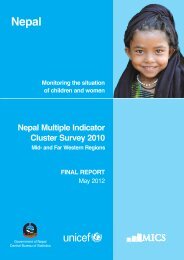Small Area Estimation of Poverty
Small Area Estimation of Poverty
Small Area Estimation of Poverty
- No tags were found...
You also want an ePaper? Increase the reach of your titles
YUMPU automatically turns print PDFs into web optimized ePapers that Google loves.
etween households in the VDC applies to this higherlevel. As a result we can thus be fairly confident thatthe standard errors in this paper are not overstating theprecision <strong>of</strong> our estimates.To allow for heteroskedasticity in the household errorcomponent, a model <strong>of</strong> the variance <strong>of</strong> εε chconditional onselected variables can be applied. Such a model (“alphamodel”) is used for the Central/Eastern and Westernregions but not for the Mid/Farwestern region 4 . TablesA5-A9 in Appendix I (<strong>of</strong> the main document) presentthe three beta models and the two alpha models.Third, expenditure <strong>of</strong> a household in the Census ispredicted as follows:ln̂ (y ch)=X T β̂ + η̂ , (3)ch c+ε̂(ch)where β̂ , η , ε̂(ch) , and denote the estimates for β, η ,ĉ cand ε (ch). Point estimates as well as standard errors <strong>of</strong>the welfare indicators are calculated by Monte-Carlosimulations. In each simulation, a set <strong>of</strong> values β̂ andare drawn from their estimated distributions, andε̂(ch)an estimate <strong>of</strong> expenditure and the poverty rates areobtained.Originally, the ELL method also draws location errorsfrom their estimated unconditional distributions. Forthose target population for which sampled data happento be available, this approach does not make optimaluse <strong>of</strong> available information. An approach proposedby Molina and Rao (2010) combines the simulationbasedapproach with what is referred to as EmpiricalBest, which uses the observed distribution <strong>of</strong> locationerror in the sampled data. With the adjustment that thedistribution functions <strong>of</strong> the errors are estimated nonparametrically,this approach has been implementedin the PovMap s<strong>of</strong>tware. The estimations in this reportuse the Empirical Best option – thus drawing errorsfrom their estimated distributions for all areas that arenot represented in the NLSS3 while drawing from theirobserved distributions for those that are sampled.For all three regional models, and in each simulation,ln̂ (y ch) is trimmed at the observed minimum andaximum values in the Survey. Subsequently, theaverage point estimate and standard deviation <strong>of</strong>500 simulations <strong>of</strong> (3) is calculated. Finally, predictedexpenditure and poverty for all households in theCensus is aggregated to generate VDC-, target area-,ilaka-, and district-level estimates. For the calculation<strong>of</strong> poverty indices we apply a poverty line <strong>of</strong> 19,261Nepali Rupees per person/year.2.2 A note <strong>of</strong> cautionWhile the practice <strong>of</strong> estimating the consumption model(1) on three separate regions, instead <strong>of</strong> estimatingone model for the whole <strong>of</strong> Nepal, creates the benefit<strong>of</strong> potentially capturing the relationship betweenexpenditure and the observables more closely it alsomakes the results more prone to over-fitting. In general,adding more explanatory variables and reducing thenumber <strong>of</strong> observations in the consumption model willlikely improve the apparent fit <strong>of</strong> the model measuredby R2. However, the larger the number <strong>of</strong> explanatoryvariables relative to the number <strong>of</strong> observations inthe sample, the larger the uncertainty associated withthem. It is therefore important to carefully examinethe fit <strong>of</strong> the models. This is done by taking a 50%random subsample <strong>of</strong> each survey region; treating onehalf (“subsample 1”) as the household survey and theother half (“subsample 2”) as the census. Using thesedatasets while repeating steps 2 and 3 outlined above,we can then compare the predicted poverty incidence insubsample 2 against the actual poverty incidence that isobserved. Since the households in subsample 2 are notincluded in the sample on which the model is calibrated,being able to predict poverty accurately suggest that theconsumption model is not too specific. A second wayin which we ascertained that the consumption modelis general enough that our final consumption modelsinclude only variables that are statistically significantat the 5% level on this random 50% subsample <strong>of</strong> theregions.Another thing to keep in mind is the usability-certaintytrade-<strong>of</strong>f. Introducing a lower level <strong>of</strong> aggregationthan that has been used before makes these maps andestimates more attractive to use for anti-poverty policymakingin Nepal. However, this comes at the cost <strong>of</strong>precision in the estimates. The fewer the households inthe area, the higher the standard error typically is, andthe less precise the point estimates. Especially whenranking target areas in terms <strong>of</strong> poverty rates, the useris strongly advised to take the reported standard errorinto account.4. Alpha models can reduce the influence <strong>of</strong> large residuals, thereby potentially improving small-area results. Typically their explanatory power is low, as we also find for our alphamodels; Central/Eastern R2=0.023, Western R2=0.035. For Mid/Farwestern, adding the alpha model causes point estimates to change only marginally while reducing averageprecision.NEPAL <strong>Small</strong> <strong>Area</strong> <strong>Estimation</strong> <strong>of</strong> <strong>Poverty</strong>, 2011, Summary and Major Findings 3
















